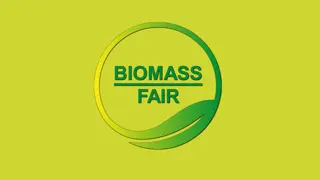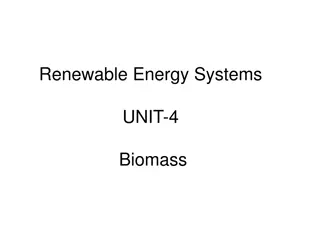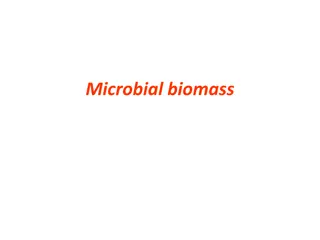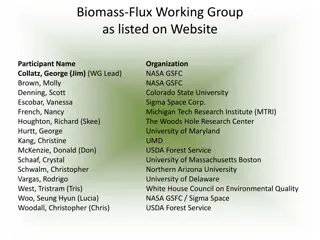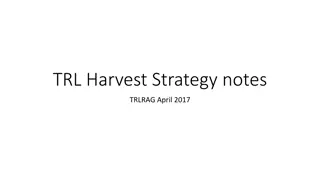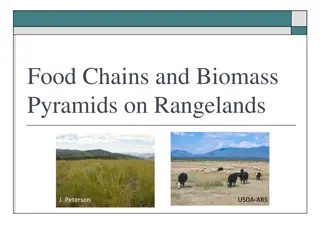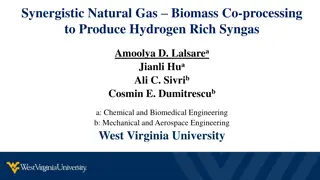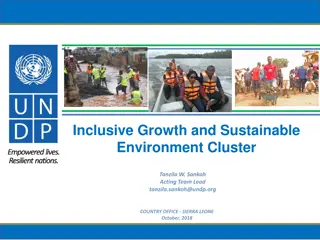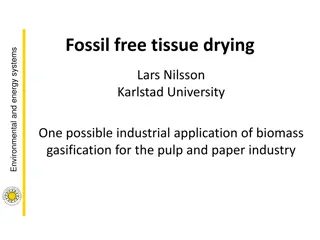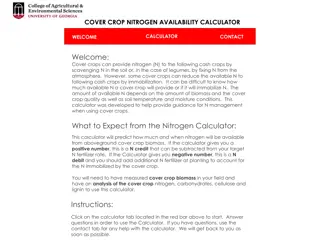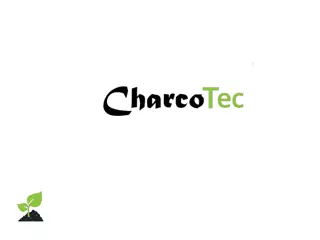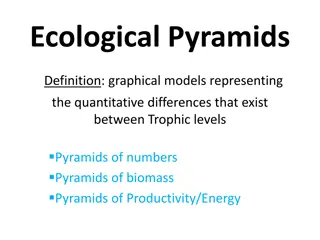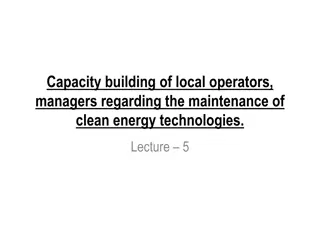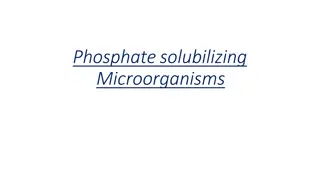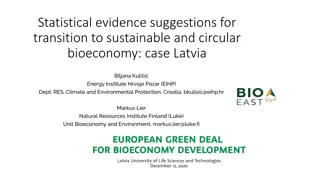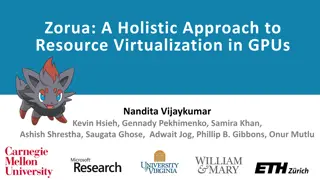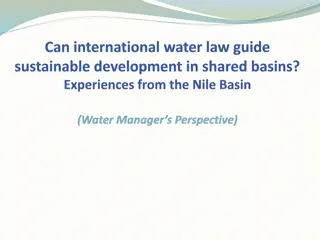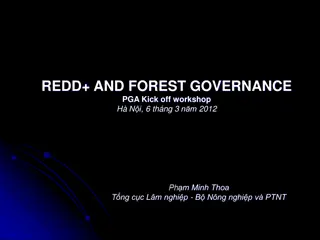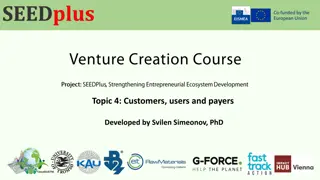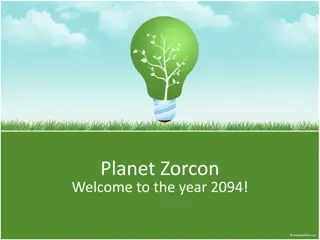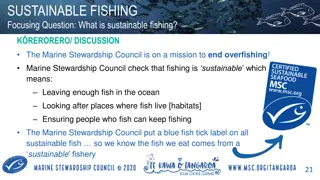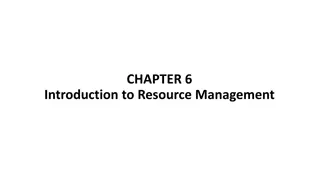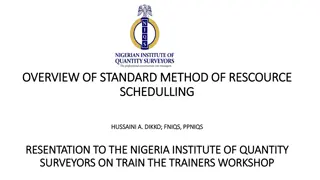Exploring the Evolution of Biomass in BioHubs for Sustainable Resource Management
Advancements in biomass utilization through BioHubs offer a sustainable solution to address global agendas like climate change and resource depletion. Biomass serves as a crucial alternative to fossil fuels, providing a renewable source for essential carbon-based molecules. Various biomass sources, such as forestry residues and urban waste streams, offer diverse opportunities for creating valuable biobased products. The development of specialized BioHubs can enable efficient utilization of surplus biomass, benefitting both the environment and the economy.
Download Presentation

Please find below an Image/Link to download the presentation.
The content on the website is provided AS IS for your information and personal use only. It may not be sold, licensed, or shared on other websites without obtaining consent from the author. Download presentation by click this link. If you encounter any issues during the download, it is possible that the publisher has removed the file from their server.
E N D
Presentation Transcript
Biomass Comes of Age Introducing BioHubs: The high level sector drivers; The role for surplus biomass; and The crucial benefits for MSW managers Regional BioHub Forum Thursday, 13th February 2014 University of New England, Armidale
The Drivers The Need & the Opportunity In the face of the related global agendas of: Climate change; Resource depletion, and the need to establish Sustainable economic systems; a definitive conclusion is the need to limit the use of fossil fuel resources and so to reduce Greenhouse Gas accumulation in the atmosphere.
Biomass Comes of Age The only logical source of supply for carbon based molecules in a resource depleted and carbon constrained future. The original source of the solar powered conversion of atmospheric carbon(CO2) into vegetative biomass the original source of fossil fuels that we are being discouraged to use. Waste biomass no longer the ugly ducking .
Essential Biobased Products Modern complex economies cannot operate without the carbon based molecules currently supplied by fossil resources, for the full range of uses and drop in alternatives, including: The complete range of chemicals and products from the integrated petrochemical sector; Coke/coal/reductant materials that are essential for the metals manufacturing/smelting sector; The agricultural fertilizer/soil productivity sector; and Specialised and liquid transport fuels sector, with special focus on aviation fuels. NB: More than just compost or firewood. Bioenergy as an important by-product.
Biomass Sources Biomass currently presents as 5 generic sources (defined by commercial circumstances at point of presentation): 1. Forestry and Agricultural harvest residues Characteristics: seasonal or campaign availability but homogeneous by-product of core activity. Value adding wastes & residues to make the primary activity more profitable 2. Forestry and Agricultural processing residues Characteristics: regularly available, homogenous and geographically concentrated but a supply pushed by-product. 3. Urban waste streams Characteristics: end of (first) life arisings to be recovered as reliable, but heterogeneous flows via streaming/cascading systems. 4. Land Management & Development Arisings Characteristics: one off or irregular arisings of potentially high value homogeneous biomass. Will benefit from shared systems & infrastructure over time 5. Specially grown or generated biomass Characteristics: highest quality, reliably available but most expensive as primary production costs to be recovered in sale of materials. Needs cost effective outlet for by-products.
Highest Net Resource Application of Available Biomass Table 1: Comparison of benefits and properties of non fossil sources Features/Properties D E A B C F G H I PetroChem industry manufacturing precursors Potential to be Carbon negative Low carbon energy sources On demand supply Renewable Heat Power Gas Oil Char Fossil fuels with sequestration Hydro Wind Solar thermal Solar PV Geothermal Wave/Tidal Nuclear Biomass Whilst <100yrs biomass can be converted to fulfil all the roles currently provided by fossil resources there is nowhere near enough so should be applied to highest and best uses bioenergy as a by-product.
Biomass comes in 5 Distinct Types 1 Sustainability of biomass yield 2 $ Value/gate fees likely to be realised at the gate of the initial processing centre (or BioHub) 3 Reliability/predictability of supply or availability 4 Relative quality of material Input materials that pay a disposal fee to the facility operator Biomass Source Input materials that need to be paid for Sporadic, campaign based, unreliable 365 days/yr Regular but seasonal -$200 0 $200+ Homogeneous Heterogeneous 1. Agricultural & forest residues 2. Downstream processing of agricultural & forest materials 3. Urban wastes a) MSW organics b) Green/garden wastes c) C&D/C&I wood wastes 4. Land management residues a) Development/infrastructure maintenance operations b) Woody weed/land management sources 5. Special purpose plantings a) Agroforestry b) Dedicated plantations c) Algae and similar 0-----------150 X X X (30)-----------100 X X Essential prerequisite for all sources if the benefits over using fossil resources are to be fully achieved and monetized. (100)----------0 (50)----0 (60)-----0 X X X X X X X (20)-----50 (20)-----50 X X X X 0------80 50-------150 50-------150 X X X X X X X X NB: Integration and collaboration across all the biomass sources necessary to achieve cost effectiveness of final products.
What is a BioHub? A scrap yard for waste or surplus biomass A receiver of last resort A rail head silo for specifically grown biomass A first point of receival The first point of assessment, value adding and/or pretreatment for whatever materials is presented.
The Main Features of a BioHub Making finished/tailored products from the full range of available materials to ensure customer satisfaction: Fertilizers Metallurgical charcoals Bioenergy Supply to high capital processors up the supply chain Servicing local communities as part of an integrated network Some too much supply not enough local markets Some too much product demand no biomass supply Very few Goldilocks opportunities hence network and collaboration
Whole of Life Cycle Materials Management (contd. ) Key: 1 The productive economy 1aPrimary industry 1b Manufacturing 1cConsumer 2 Point of discard for metropolitan solid waste (MSW) 2a Point of discard for commercial and industrial (C&I) waste 3 First point of receival for residual MSW 4 First point of receival for dry recyclables 5 First point of receival for organics 6 Return of materials into the productive economy metals 7 Return of materials into the productive economy inerts 8 Return of materials to the productive economy mixed organics and biomass 9 Return of materials to the productive economy high calorific and hydrocarbon-based materials 10 Return of materials to the productive economy source-separated organics 11 Point of discard occasional, bulky, valuable or hazardous materials 11a Point of discard valuable or toxic C&I 12 Special value recovery facilities 13 Treatment and detoxification facilities 14 Return of materials to the productive economy treated toxics and household hazardous 15 Return of materials to the productive economy special value recovery
Making Real Products from Waste (Creating the market pull for recovered resources back into the productive economy) Lessons learned for biomass fraction: Paper/cardboard Glass Metals Two stage process: Waste sector Fee-for-Service collect and pretreat Product manufacturing Consumer facing Based originally on virgin supplies Lives and dies on product quality Success requires recovering resources from urban waste streams such that they can beneficially supplement/replace virgin resources in established product manufacturing.
What an Integrated Streaming/Cascading System Could Look Like for New England 11Markets End Uses Discard Options First Point of Receival Specialist Reprocessing 1 Return to manufacturer Brand 6 DROP OFF Sell to highest bidder Hard Waste A Market Treatment (on behalf of originator?) As directed Residue HHW Residual MSW(Red) Inerts B C Civil applications Metals HCF/synthetics 5 Scrap VATS/AWT 2 C&I (and C&D) pre-sorted 7Polymer recovery Petrochem RDF/PEF Residues Confirmed markets / end users D Recyclables Rejects Residuals Recyclables to market directly or via MRF Paper/cardboard Colour sorted glass Metals Polymer sorted plastics 3 Regional Organics Agricultural & forest harvest residues Agricultural & forest processing residues Land management residues Special purpose plantings Established markets & end users 4 MRF E Yellow 8 Compost Torrefaction Pyrolysis Third party supply Green power Residue F Compost Confirmed char/ charcoal specialty markets Green Power Organics Wood/organics Garden G Residues 9 Modular EfW H Black Power and / or Ash 10 Landfill Non putrescible >90% diversion
Projected Benefits for Councils > 90% diversion Cap on waste management charges immediately: Then CPI certainty Then downward pressure on costs and charges No need to take process and market risk Opportunity to invest in profitable resource recovery operations Encourage and facilitate growth and employment Ultimately financed from the recovered value from the materials under management
Only Collaboration Can Achieve these Results No single industry sector can achieve optimum results on their own No council can achieve optimum results on their own It requires: Regional collaboration Multi council based strategies Multi product flexibility Technology as servants not masters Governments (x3) to support initial scoping, planning and feasibility studies
Green/Garden Waste Management for Best Quality and Value Demographic Survey Data Council owned parks & gardens Conscientious and motivated Home Multi Occupation Conscientious, motivated, active 30% Conscientious, motivated, inactive 40%? Can t be bothered Conscientious and motivated Can t be bothered Waste Audit Data Mixed putrescible ( )%? Vege food preparation ( )%? Small garden ( )%? Large garden ( )%? Wood/stumps ( )%? 30%? 50%? 50%? 100%? Likely Quality/Quantity Assessment* *Potential values to be then compared with the status quo and the cost/benefit of the alternative schemes


